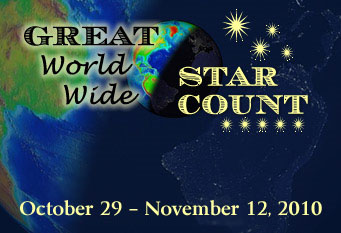Unless you've been living a hermit's life on a remote mountaintop for the past decade, you know that light pollution is slowly whitewashing the stars from view. My S&T colleague Tony Flanders has posted several excellent blogs on this topic, such as this one.

Windows to the Universe / UCAR
So how starry is your starry night sky? You can find out easily, thanks to a sky-awareness campaign called Great World Wide Star Count. It'll take just 20 minutes or so, and you'll be joined by thousands of equally-curious skygazers around the globe. Do it on your own, with your family, or as part of a larger group.
All you'll need are a clear evening sky sometime between October 29th and November 12th, your own two eyes, and a set of simple star charts. First, download the handy five-page activity guide (available in 11 languages) and print the star charts. If you live in the Northern Hemisphere, you'll be looking high up for the constellation Cygnus, and its Northern Cross asterism. If you're south of the equator, the target area surrounds the Teapot in Sagittarius. Each of the seven maps shows stars down to a different magnitude limit, plus one for a cloudy sky.
Then, after stepping out under the early-evening sky and letting your eyes adjust to the darkness, match one of the charts to what you see overhead. Step back inside and report what you've found online. You're done!
Unlike many contests, you can enter this one more than once! You might be surprised by how much the sky's darkness can vary from night to night, or between locations only 1 or 2 miles apart.
Want to find out how quickly your eyes adapt to darkness? You can take a measurement as soon as you step outside, followed by another 15 or 30 minutes later.
GWWSC is a managed by UCAR's Windows to the Universe project. The efforts in 2007, 2008, and 2009 netted nearly 12,000 observations from 64 countries. This is a great example of "citizen science" that's helping to raise dark-sky awareness in every corner of the globe.
So, again I ask: How dark is your night sky? Join the Great World Wide Star Count and find out!
 6
6









Comments
Nick Weber
October 28, 2010 at 7:08 pm
This sounds like an amazing way to get the public involved in amateur astronomy! I am going to print the guide out and give it to the astronomy teacher at my school for his class.
Also sounds like something we should do at the Clay Center Observatory!!
You must be logged in to post a comment.
Bill Simpson Slidell LA.
October 29, 2010 at 10:41 am
Depending on where you live, as little as 5 miles can make a big difference in the amount of light pollution. If I drive from my home on the northern edge of Slidell, LA to the Stennis Space Center, the Milky Way is still visible about 30 degrees above the horizon, even though NASA likes to keep their rocket test stands lit up like Christmas trees. Maybe they are afraid they will get stolen or colonized by raccoons while no one is working and the guards are all asleep. Being a government installation, they might have to do a multi-year EIS before they could remove them. A few hundred 500 watt high pressure sodium vapor lights keep those raccoons at bay year-round. What's a little more air pollution.
I just wish I could find an accurate, detailed light pollution map. And have you ever noticed how the perfect spot is always ruined by some cluster of lights. It is often some industrial site that uses a couple of million watts of vapor lights that point straight out from the fixtures. They light up piles of gravel all night like they are stacks of gold bars. They must be afraid of thieves arriving by parachute. Don't get me started on parking lots and upward lit billboards.
You must be logged in to post a comment.
Ivan Dorjee Lepcha
October 29, 2010 at 11:27 pm
Such an activity involves anumber of enthusiasts all at the same time ... which is good thing! because usually people think that astronomy involves only a telescopic observation !
Thanks for the massive endeavour
You must be logged in to post a comment.
Vladimir
October 31, 2010 at 9:27 am
Interestigly, how 6 new languagies of the guide are able to help increase the final amount of the observations. Judging from the 2009 chart, one can see that vast areas of the planet, except North America and Europe, are actually "void".
You must be logged in to post a comment.
karl hoewt
November 1, 2010 at 1:49 pm
Slidell here too! Just moved here form Pensacola back in June and have noticed a darker sky here.
You must be logged in to post a comment.
morteza hamzehzadeh
November 13, 2010 at 4:02 am
I see this post today but it's too late to join the Great World Wide Star Count.
You must be logged in to post a comment.
You must be logged in to post a comment.